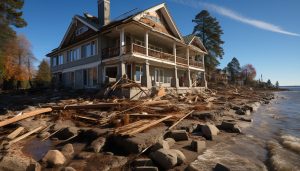You are not alone if your home insurance premiums have increased or if your coverage has been canceled.
The climatic catastrophe is now also a financial one, as seen by Florida floods and California wildfires. Globally, insurers are reevaluating risk, exiting susceptible markets, and raising premiums for all.
The problem is that you can feel the heat even if you do not reside in a flood zone.
Let us discuss what is going on, why it matters to you, and how to safeguard your finances wisely.
Insurance Is Being Rapidly Disrupted by Climate Change

Predictable risk is the cornerstone of the insurance sector. However, predictability is disappearing as climate-related disasters increase in frequency and severity.
NOAA reports that in 2023 alone, there were 28 billion-dollar disasters in the United States, setting a new record. Insurers receive enormous payouts from natural disasters like hurricanes and hailstorms.
What comes next, then? They adapt:
Increased premiums for all
More renewals that are refused
More stringent underwriting guidelines
Total departures from states of high risk
Major insurers are either pausing new coverage or withdrawing completely from states like Louisiana, Florida, and California. You are probably spending more to compensate for the higher national risk, even if you reside in a comparatively “safe” place.
It Affects Your Auto Insurance as Well
It goes beyond home insurance. The climate is a hidden factor contributing to the increase in auto insurance costs.
Claims increase when floods or excessive heat destroy roadways. It is no surprise that rates are rising when you factor in labor shortages and delays in the auto parts supply chain.
Life and Health Insurance? Sensing the Ripple as Well

Longer allergy seasons, heat-related illnesses, and waterborne infections are some of the ways that climate change impacts human health. Environmental risk exposure is now taken into account by life and health insurers when setting policy prices.
Some businesses are even evaluating medical risk and longevity using climatic data.
Scary? Yes. It is a wake-up call, though.
Ways to Keep Yourself (and Your Money) Safe
What you can do now is as follows:

Every year, review your policies. Recognize what is and is not covered. Do not assume damage from mold, floods, or wildfires is covered.
Think about getting additional insurance. Coverage for earthquakes and floods typically calls for different policies.
Make your house more durable. Improve drainage, raise utilities, or install fire-resistant materials. For mitigation, insurers may provide discounts.
Look around. In insurance, loyalty is not always profitable. Obtain prices, evaluate coverage, and inquire about discounts for driving behaviors, smart home technology, or bundling.
Speak with an actual person. Automated chatbots and comparison tools might be confusing. However, insurance is a personal matter. An agent or broker can assist in customizing coverage to meet your unique requirements.
Conclusion: Insurance Is a Climate Resilience Tool, Not Just a Policy
The truth that most headlines do not include is this: One of the first areas where the financial effects of climate change are seen by regular people is in insurance.
It is no longer a far-off policy matter or something that is taking place “over there.” It can be found in your refused claims, your renewal notice, and your increasing rates.
However, knowledge is power. And no matter what, you can safeguard your family, your house, and your peace of mind by taking the appropriate actions.



